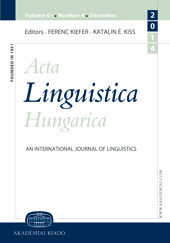The realisation of voicing assimilation rules in Hungarian spontaneous and read speech: Case studies
The realisation of voicing assimilation rules in Hungarian spontaneous and read speech: Case studies
Author(s): Alexandra Markó, Tekla Etelka Gráczi, Judit BónaSubject(s): Phonetics / Phonology, Finno-Ugrian studies
Published by: Akadémiai Kiadó
Keywords: Hungarian voicing assimilation; pauses; partially voiced consonants; three-member clusters; speech planning;
Summary/Abstract: Hungarian represents a particularly fruitful ground for exploring voicing assimilation. Although this topic has been extensively analysed, a contradiction can be observed between most phonological descriptions and acoustic-phonetics-based studies of voicing assimilation. Theoretical works suggest that this process in Hungarian speech is a purely regressive, obligatory and categorical phenomenon, but in practice divergent realisations can be observed. In the present paper three case studies of voicing assimilation are performed. CCC clusters, CC clusters interrupted by pause and partially voiced realisations were analysed. The results showed that in the first two cases the speech planning process and the degree of self-monitoring were the most influential factors, while the various concomitances of voicing and devoicing arising due to aerodynamic and articulatory reasons resulted in partially voiced realisations. The variability of the data confirms the hypothesis that Hungarian voicing assimilation is a gradient and sometimes only partly regressive process. Even if it operates mainly obligatorily, several factors can override it.
Journal: Acta Linguistica Hungarica (Since 2017 Acta Linguistica Academica)
- Issue Year: 57/2010
- Issue No: 2-3
- Page Range: 210-238
- Page Count: 29
- Language: English

